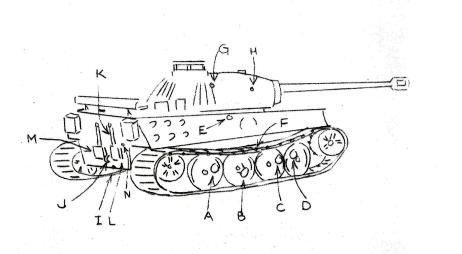HEADQUARTERS
5th TANK DESTROYER GROUP
APO 758, U.S. ARMY
1. To ascertain from first hand observation the effect of bazooka fire on the Mk. V Panther tank, sixteen rounds were fired at a knocked out 130 Pz Lehr Mk. V. which had been immobilized by the 776 TD Bn's 90mm fire.
2. Diagram of tank indicating location of hits:

Description of Hits
a. Ricochet into wheel rim completely severing the tire and blasting an 8" hole in the wheel. There was no damaging effect upon the inner wheel immediately behind the one hit.
b. Direct hit upon a wheel. A 3 x 5" hole was blasted out of the wheel and two 10" radial cracks were made. There was no damaging effect upon the wheel immediately inside the one hit.
c. & d. Direct hits upon wheels. 6" diameter holes blasted - no effect upon inner wheels.
e. Hit scored one inch below upper edges of side skirt. While the deck plating served to add thickness at the point of contact, a complete penetration was made, the hole being of sufficient diameter at this smallest point to allow an ordinary pencil to pass completely into the interior.
f. A hit upon the bolt holding two adjacent track plates together. The head of the bolt was sheared away completely, though the track plates were not damaged. It is possible that the bolt could have worked out, thus severing the track.
g. A hit upon the corner of the turret, making a complete penetration, The hole was cylindrical, 3/4" in diameter, with little flaking or enlargement on the inner surface. The blast effect was evident on the inside by the particles of steel having ricocheted from one side to the other.
h. A turret hit making a similar 3/4" hole with flaking on the inner surface of about 4" in diameter around the hole. There were approximately 36 small craters on the inner surface of the opposite turret armor, each at least 1/16" deep and from 1/8" - 3/8" in diameter. As the face of each pit was smooth, the blast effect of the flying particles must be terrific. The area covered by these craters was roughly 8' - 10' in diameter.
i. A hit upon the very bottom edge of the rear plate, The projectile just grazed the armor and only a small nick was chipped out of the armor. The projectile did detonate, but the effect was underneath the tank in the ground.
j. A hit upon the towing-jack device on the rear of the tank. A small portion was chipped away, but there was no effect upon the armor plate.
k. A hit upon one of the exhaust pipes, completely blasting it away, but there was no effect upon the armor plate inasmuch as the blast had been dissipated upon the exhaust pipe.
l. A ricochet off the rear armor, detonating in the ground. m.& n. Two hits in the rear armor, each making a clean penetration, the hole being 1/2" in diameter through armor plate 2" thick.
o. A hit upon the lower portion of the front armor plate. No penetration was made. A 1-1/2" long gash, 1/2" deep, and 1/4" wide was gouged away.
p. A hit upon the towing hook on the front of the tank. No damaging effect upon the armor plate.
3. CONCLUSIONS:
The bazooka will penetrate the armor on the side, rear, and side of the turret on the German Mk. V Panther tank. The turret is very effectively penetrated and the blasted particles on the inside most certainly are lethal. The side armor is of less thickness than the turret and can be penetrated more easily.
The wheel and tracks are not profitable targets. Pieces may be blown out of the wheel or tires cut, but the possibility of stopping the tank is remote.
The rear armor is a profitable target, because the engine compartment is very susceptible to fare, even though the tool boxes, jacks and exhausts are reduce the area of vulnerability.
Upon the front armor, it is difficult to get an effective burst, as the slope of the armor will ricochet the rocket. No perpendicular hits were obtained during the trial.
For the Group Commander:
EDWARD N. STIVER |
DISTRIBUTION:
Combat Observer, XV Corps - 2
CG, XV Corps - 2
1st TD Brigade - 1
Arty Sec, Seventh Army - 2
Each Division, XV Corps - 1
Each TD Battalion, XV Corps - 1
File - 2